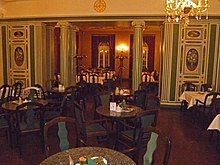Brigitta Grossmann-Lauterbach
Brigitta Großmann-Lauterbach (born April 21, 1923 in Dresden ; † July 24, 1965 there ) was a German sculptor , carver and ceramicist .
Life
Brigitta Großmann-Lauterbach tinkered with different materials in her childhood and made small figures, animals and everyday objects. This is how the rolling pin from the kitchen was once carved and painted. This created a connection to designing wood with an artistic charisma.
In 1942 she began her studies at the Dresden Art Academy with Reinhold Langner . In between, she successfully completed a works teacher examination at the teachers' seminar in Dresden. Due to the war, she interrupted her studies and continued at the Dresden Academy of Fine Arts after the war . She became a master student with Langner and worked in his studio. There she was able to express her creative joy in playing. In 1947 she successfully completed her studies and was offered a job as a toy designer at the Grünhainichen toy school. However, this position offered her too little creativity and she worked freelance in Dresden- Kleinzschachwitz .
Initially she made toys and Christmas figures , from which the construction and figurative decoration of Christmas pyramids with over 200 figures developed. She learned wood turning from Professor Winde from the Dresden Trade School. This opened up new opportunities for her to enrich her art. While working in the chapel in Reichenau near Königsbrück , she met the electrician Egon Großmann, who would later become her husband. In the destroyed Dresden, she exhibited her work in the Christmas show in the north hall. The figures and pyramids shown triggered a large number of orders. In accomplishing this task, she had support and help from her husband as an employee. Each of their pyramids was unique. Through Professor Langner she learned a wide variety of techniques and how to use clay. He taught her ceramics and she added another craft to her art.
She succeeded in building a studio building in Graupa . She had the support of the local pastor, with whom she also vividly organized the religious instruction. From this a community developed, which now itself creatively tinkered, carved and designed. For a seminary she also took on the creative work with the participants. There was also contact with the Greifswald bishop at an ephoric conference and the foundation stone for a work week was brought into being. These work weeks were carried out in numerous cities and communities such as Rostock , Greifswald , Neustrelitz and others.
This is how Saxon art came to Brandenburg. Further orders were waiting in the studio, and the German Building Academy in Berlin had commissioned some important work. Together with the wood sculptor Siegfried Urbank from Geising , she made new wooden door and wall panels with carved motifs for the rebuilt restaurant " Italienisches Dörfchen " in Dresden. She created decorative door panels and panels for a sports hall in Leipzig for the German University of Physical Culture . For the Interhotel "International" in Magdeburg , she designed and manufactured carved oak ceiling panels, as well as for the cafeteria in the Berlin zoo and the foyer and theater hall of the Leipzig Opera House . She also supported her congregation in the renovation of the Stephanus Church and decorated its interior with numerous carvings.
For over 34 churches she carved altar crosses over 2 meters in size from oak . Each one is structured differently and decorated with a wide variety of motifs. The interchangeable contents of the altar crosses represent a new artistic chapter. So different interpretations could be symbolized for the respective occasion.
During a work week in Rostock in 1962, she fell in the south hall in the Petrikirche and injured her knee and also internally. During her convalescence she designed ornate motif plates for the Doberaner Münster. Because she could no longer carve them in wood due to illness, she made them out of wax. An illness that followed weakened her; she spent a convalescent stay in Oberbärenburg . Britta Großmann-Lauterbach died on July 24, 1965 in Dresden. She was buried in the Kleinzschachwitz cemetery on July 29th.
Works (selection)
- Altar cross made of solid oak, memorial for the fallen in Techow
- Christmas pyramid for the children's home in Wermsdorf
- Christmas pyramid for the children's hospital in East Berlin
- Christmas pyramid for the Leipzig City History Museum
- Carved wooden door and wall panels with motifs for the rebuilt Italian village restaurant in Dresden
- Carved wooden door and wall panels for a sports hall in Leipzig for DHfK Leipzig
- Carved oak ceiling and wall coverings for the Interhotel International in Magdeburg
- Christmas pyramids for the Politburo in Berlin
- Carved oak ceiling and wall coverings for the foyer and the theater hall of the Leipzig Opera House
- Carved oak ceiling and wall coverings for the cafeteria in the Berlin Zoo
Web links
- Carving of St. Stephen's Church
- Elbe slope courier
- St. John's Church in Kühlungsborn
- Kleinnaundorf
- Freitaler Kirchen Friedenskapelle Kleinnaundorf
- evangelisches-Sonntagblatt
- Leubnitzer Church
- Gallery heaven
- Stephanuskirche
- https://www.europeana.eu/portal/de/record/08547/sgml_eu_php_obj_p0000396.html
- Neustrelitz Church
- beyond-time
- Village church-von-Heiligengrabe
Individual evidence
- ↑ Archive of the Dresden University of Fine Arts
| personal data | |
|---|---|
| SURNAME | Großmann-Lauterbach, Brigitta |
| ALTERNATIVE NAMES | Grossmann-Lauterbach, Brigitta |
| BRIEF DESCRIPTION | German sculptor, picture carver and ceramicist |
| DATE OF BIRTH | April 21, 1923 |
| PLACE OF BIRTH | Dresden |
| DATE OF DEATH | July 24, 1965 |
| Place of death | Dresden |
